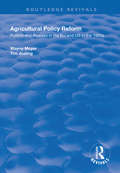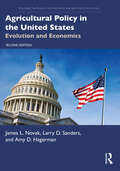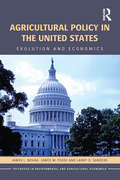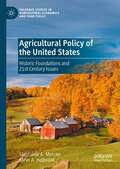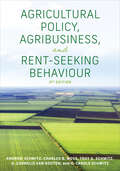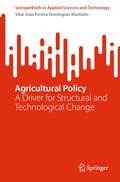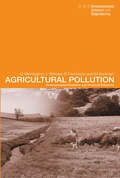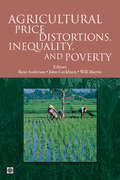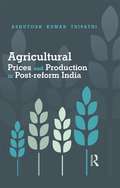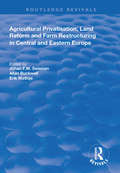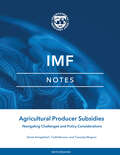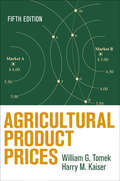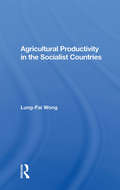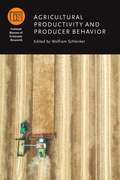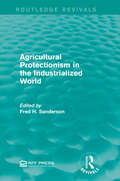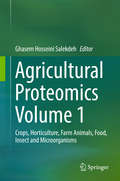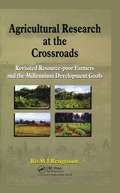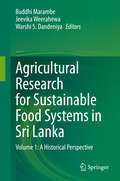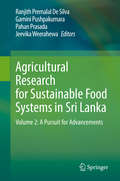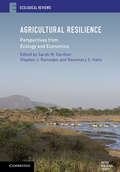- Table View
- List View
Agricultural Policy Reform: Politics and Process in the EU and US in the 1990s (Global Environmental Governance Ser.)
by Tim Josling Wayne MoyerThis title was first published in 2002. This engaging work examines the interplay between US and EU agricultural trade policy reforms, as well as the linkage between domestic and trade policy reform, and addresses whether reform is likely to continue during the first decade of the 21st Century. Features include: - Comprehensive overview of the interplay between domestic and international agricultural policy reform - Detailed analysis of the paradigm shift in policy - Vigorous discussion of the potential impact of emerging issues such as GMOs, intellectual property rights, animal and plant health, and human safety The book offers a rich empirical account of politics and diplomacy over the last decade, providing an important background for explaining forthcoming agricultural policy debates in the US, the EU and agricultural policy negotiations in the WTO.
Agricultural Policy in the United States: Evolution and Economics (Routledge Textbooks in Environmental and Agricultural Economics)
by James L. Novak Larry D. Sanders Amy D. HagermanAgricultural Policy in the United States: Evolution and Economics traces U.S. agricultural policy from its colonial roots to the present, using economic concepts to analyze and interpret political and economic consequences. It also examines the processes by which agricultural policies are developed, and the government structure which supports the implementation of legislation passed by Congress. The book includes arguments for and against common tools of U.S. agricultural policy, without influencing the reader in a particular direction. Each chapter contains questions and exercises to support students’ learning, and technical economic material is contained in optional appendices. This second edition examines the Agriculture Improvement Act of 2018 and sets the scene for future policy developments. Additionally, it looks at trade wars and the impact of Black Swan events like the COVID-19 pandemic on agricultural resilience.
Agricultural Policy in the United States: Evolution and Economics (Routledge Textbooks in Environmental and Agricultural Economics)
by James L. Novak James W. Pease Larry D. SandersAgricultural Policy in the US: Evolution and Economics traces the foundation of US agricultural policy from its colonial roots to the present, using economic concepts to analyze and interpret political and economic consequences. Ancient Roman food and agricultural reform, English Corn Law and other historic examples of agricultural policies are included to show that agricultural policy has a long history and has been found necessary for governance throughout history. Processes employed to develop US agricultural policies, the structure and function of government that develops and implements agricultural policy, and the specific evolution of policy from the early twentieth century to the Agricultural Act of 2014 are included. Specific policies in past farm bills are detailed in order to track their evolution and economic effects. This textbook includes arguments for and against common tools of US agricultural policy. This debate continues today and can be seen in a gradual change over time from taxes and tariffs to risk management. Information presented does not attempt to influence the readership towards a pro or con position but rather to present information to help the readers to understand the issues related to agricultural policy in the US.
Agricultural Policy of the United States: Historic Foundations and 21st Century Issues (Palgrave Studies in Agricultural Economics and Food Policy)
by Stephanie A. Mercier Steve A. HalbrookThis book serves as a foundational reference of U.S. land settlement and early agricultural policy, a comprehensive journey through the evolution of 20th century agricultural policy, and a detailed guide to the key agricultural policy issues of the early 21st century. This book integrates the legal, economic and political concepts and ideas that guided U.S. agricultural policy from colonial settlement to the 21st century, and it applies those concepts to the policy issues agriculture will face over the next generation. The book is organized into three sections. Section one introduces the main themes of the book, explores the pre-Columbian period and early European settlement, and traces the first 150 years of U.S. agricultural policy starting with the post revolution period and ending with the “golden age” of agriculture in the early 20th century. Section two outlines that grand bargain of the 1930s that initiated the modern era of government intervention into agricultural markets and traces this policy evolution to the early days of the 21st century. The third section provides an in-depth examination of six policy issues that dominate current policy discussions and will impact policy decisions for the next generation: trade, environment/conservation, commodity checkoff programs, crop insurance, biofuels, and domestic nutrition programs.
Agricultural Policy, Agribusiness and Rent-Seeking Behaviour, 2nd Edition
by Charles B. Moss Troy G. Schmitz Hartley Furtan Andrew SchmitzThe second edition of the groundbreaking Agricultural Policy, Agribusiness, and Rent-Seeking Behaviour expands upon its original analysis of the economic policies that affect agriculture and agribusiness. Widening their lens to include information on the European Union, the authors continue to emphasize the role of farmers and agribusiness in the formation of policy, exploring the issues from both economic and historical perspectives.More theoretical than the first volume in its discussions of welfare economics and the theory of public choice, the second edition also addresses the broad significance of agricultural policies such as biofuels, nutrition, multifunctionality, genetically modified organisms, and multinational firms. The authors maintain and expand the empirical content to provide more practical examples suited to teaching and analyse specific problems including price and income stabilization, science policy, environmental policy, and food quality and safety.
Agricultural Policy, Agribusiness, and Rent-Seeking Behaviour, Third Edition
by Troy G. Schmitz Andrew Schmitz Charles Moss G. Cornelis van Kooten H. Carole SchmitzCosting billions of dollars annually, international trade in agricultural products is impactful and influenced by several factors, including climate change, food policy, and government legislation. The third edition of Agricultural Policy, Agribusiness, and Rent-Seeking Behaviour provides comprehensive economic analyses of the policies that affect agriculture and agribusiness in Canada and the United States. Looking at current agricultural policies, the third edition includes new chapters on food pyramids, climate change, and GMOs, while also highlighting the effect of international policies on Canadian trade, including the problematic US ethanol policy. The new edition addresses current issues, including how the COVID-19 pandemic has negatively affected agricultural value chains and played a hand in the ongoing growth in opioid use. Including a number of key findings, and discussing current debates on topics including foreign ownership of Canadian farmland, Agricultural Policy, Agribusiness, and Rent-Seeking Behaviour will appeal to students in agricultural economics and policy, as well as policymakers, agricultural firms, energy companies, and readers wishing to reduce their nation’s carbon footprint.
Agricultural Policy: A Driver for Structural and Technological Change (SpringerBriefs in Applied Sciences and Technology)
by Vítor João MartinhoThis book gives insights into the agricultural policies in several countries located in different continents. It is of interest to students, researchers, and policy and decision makers.Given the particularities of agriculture, agricultural policies are indispensable for an adjusted development of farms according to the strategic objectives of each country, namely the socio-economic and environmental ones. The question that often arises is whether the practical effects of the various policy measures are in accordance with their design and what is the effect of these policy instruments among many other causes of structural and technological change. The aim of this book is to describe the main agricultural policies that have been implemented in countries such as the United States of America, Brazil, China, India, South Africa, Australia, as well as the European Union. It also aims to analyse the real impact of these policies on the structural and technological changes of farms in the European Union. As its methodology, the book considers bibliometric analysis, literature review and statistical approaches.
Agricultural Policy: Farm Programs and National Welfare
by Rainer SchickeleThis book is written for the student of rural America, be he farmer, businessman, labor leader, public servant, college student, or instructor, anyone who is curious to understand what problems farmers are facing in their relations to an industrial world, and what the government is doing to help them meet these problems.
Agricultural Pollution: Environmental Problems and Practical Solutions
by R. Parkinson Graham Merrington Dr Linton Nfa Mark Redman L. WinderThis comprehensive text provides a concise overview of environmental problems caused by agriculture, (such as pesticide pollution and increased nitrate levels) and offers practical solutions to them. It is well illustrated and contains a fully-referenced introduction to the main contemporary agricultural pollution issues in the UK. It will help pro
Agricultural Practices and Policies for Carbon Sequestration in Soil
by R. Lal J. M. Kimble R. F FollettThe potential to mitigate greenhouse gas emissions and global climate change is one factor driving agricultural policy development of programs that might pay farmers for practices with a high potential to sequester carbon. With chapters by economists, policy makers, farmers, land managers, energy company representatives, and soil scientists, Agricu
Agricultural Price Distortions, Inequality, and Poverty
by Kym Anderson Will Martin John CockburnThe prices of farm products are crucial determinants of the extent of poverty and inequality in the world. The vast majority of the world's poorest households depend to a considerable extent on farming for their incomes, while food represents a large component of the consumption of all poor households. For generations, food prices have been heavily distorted by government policies in high-income and developing countries. Many countries began to reform their agricultural price and trade policies in the 1980s, but government policy intervention is still considerable and still favors farmers in high-income countries at the expense of many farmers in developing countries. What would be the poverty and inequality consequences of the removal of the remaining distortions to agricultural incentives? This question is of great relevance to governments in evaluating ways to engage in multilateral and regional trade negotiations or to improve their own policies unilaterally. 'Agricultural Price Distortions, Inequality, and Poverty' analyzes the effects of agricultural and trade policies around the world on national and regional economic welfare, on income inequality among and within countries, and on the level and incidence of poverty in developing countries. The studies include economy-wide analyses of the inequality and poverty effects of own-country policies compared with rest-of-the-world policies for 10 individual developing countries in three continents. This book also includes three chapters that each use a separate global economic model to examine the effects of policies on aggregate poverty and the distribution of poverty across many identified developing countries. This study is motivated by two policy issues: first, the World Trade Organization's struggle to conclude the Doha Round of multilateral trade negotiations, in which agricultural policy reform is, again, one of the most contentious topics in the talks and, second, the struggle of the developing countries to achieve their Millennium Development Goals by 2015-notably the alleviation of hunger and poverty-which depends crucially on policies that affect agricultural incentives.
Agricultural Prices and Production in Post-reform India: An Inquiry Into The Post-reform Period
by Ashutosh Kumar TripathiPost-reform India has seen a decline in agricultural growth as well as supply–demand imbalance and rising prices. This book presents a comprehensive analysis of domestic and international prices and trade since 1980–81, covering the past quarter of a century. Backed with rich data, it provides comparisons between the pre- and post-liberalisation policies and their effect on farm profitability, domestic prices and prices variability, and examines their possible role in determining the trajectory of agricultural growth since 1991. The book will appeal to students, scholars and researchers of agriculture studies, economics, finance, and development studies, as well as policy makers and agriculture experts.
Agricultural Privatization, Land Reform and Farm Restructuring in Central and Eastern Europe (Routledge Revivals)
by Johan F.M. Swinnen Allan Buckwell Erik MathijsFirst published in 1997 in the wake of the fall of the Soviet Union and its agricultural policies, these editors presented a series of ten related articles on the transition to post-communist, more privatised agricultural policies, each specialising in a specific region of Central and Eastern Europe. Resulting from a research network, this volume features a range of contributors, including those preparing PhDs, former governmental advisors and specialists in agricultural economics, food policy and statistics. The chapters cover Albania, Bulgaria, the Czech Republic, Eastern Germany, Hungary, Romania, Slovakia, Solvenia, and the Former Soviet Union, along with a comparative analysis. The contributors focus on three key issues of reform: the collection of detailed data, the collection of information on factors influencing the progress and completion of reform and explaining the results of privatisation and land reform, with a particular emphasis on the first two elements. This volume is well-suited to policy makers, analysists and researchers.
Agricultural Producer Subsidies: Navigating Challenges and Policy Considerations
by MoguesA report from the International Monetary Fund.
Agricultural Product Prices
by Harry M. Kaiser William G. TomekPublished continuously since 1972, Agricultural Product Prices has become the standard textbook and reference work for students in agricultural and applied economics, buyers and sellers of commodities, and policymakers, clearly explaining conceptual and empirical models applicable to agricultural product markets. The new fifth edition uses up-to-date information and models to explain the behavior of agricultural product prices. Topics include price differences over market levels (marketing margins), price differences over space (regionally and internationally) and by quality attributes, and price variability with the passage of time (seasonal and cyclical variations, trends, and random behavior). William G. Tomek and Harry M. Kaiser review and adapt microeconomic principles to the characteristics of agricultural commodity markets and then apply these principles to the various dimensions of price behavior. They also provide an in-depth discussion of prices established for futures contracts and their relationship to cash (spot) market prices; cover the influential roles of price discovery institutions, such as auctions and negotiated contracts, and government policies regulating trade and farms; and discuss the specification, use, and evaluation of empirical models of agricultural prices, placing emphasis on the challenges of doing high-quality, useful analyses and interpreting results.
Agricultural Productivity In The Socialist Countries
by Lung-fai WongWith the emergence of collectivization, the communal movement, and the food crisis, the development of agriculture in socialist countries has become a topic of great interest to economists. Focusing on productive efficiency, Dr. Wong estimates an agricultural metaproduction function for nine countries--China, Bulgaria, Czechoslovakia, East Germany, Hungary, Poland, Romania, Yugoslavia, and the Soviet Union--and computes both the partial productivities and total productivity in comparable units. Using the growth accounting procedure, the author performs a quantitative comparative analysis of the differences and the sources of differences in agricultural productivity among socialist countries. Methods of analyzing productivity measures are described, revealing the contribution of land, labor, education, and other factors in agricultural growth. Dr. Wong concludes by discussing the policy implications for development strategy and the effects on the world food market.
Agricultural Productivity and Producer Behavior (National Bureau of Economic Research Conference Report)
by Wolfram SchlenkerAgricultural yields have increased steadily in the last half century, particularly since the Green Revolution. At the same time, inflation-adjusted agricultural commodity prices have been trending downward as increases in supply outpace the growth of demand. Recent severe weather events, biofuel mandates, and a switch toward a more meat-heavy diet in emerging economies have nevertheless boosted commodity prices. Whether this is a temporary jump or the beginning of a longer-term trend is an open question. Agricultural Productivity and Producer Behavior examines the factors contributing to the remarkably steady increase in global yields and assesses whether yield growth can continue. This research also considers whether agricultural productivity growth has been, and will be, associated with significant environmental externalities. Among the topics studied are genetically modified crops; changing climatic factors; farm production responses to government regulations including crop insurance, transport subsidies, and electricity subsidies for groundwater extraction; and the role of specific farm practices such as crop diversification, disease management, and water-saving methods. This research provides new evidence that technological as well as policy choices influence agricultural productivity.
Agricultural Productivity: Measurement and Explanation (Routledge Revivals)
by John M. Antle Susan M. CapalboThis book, first published in 1988, provides a comprehensive, integrated body of knowledge concerning agricultural productivity research, highlighting both its strengths and limitations. This book will be of value to scholars and research leaders for the knowledge it conveys of future productivity research, and will also be of interest to students of environmental studies.
Agricultural Protectionism in the Industrialized World (Routledge Revivals)
by Fred H. SandersonOriginally published in 1990, Agricultural Protectionism in the Industrialized World takes a detailed look into the domestic and international agricultural policies of the United States, Europe, Canada, Japan, Australia and New Zealand. These areas are some of the most industrialised in the world and this study focuses on the benefits, policies and costs related to protectionism of their agriculture. These papers offer detailed analysis of the evolution, objections and domestic and international implications related to agriculture in specific countries as well as taking a global view of issues such as policy, trends and costs and concluding with a discussion on the effects of free trade. This title will be of interest to students of environmental studies.
Agricultural Proteomics Volume 2: Crops, Horticulture, Farm Animals, Food, Insect and Microorganisms
by Ghasem Hosseini SalekdehThis book will cover several topics to elaborate how proteomics may contribute in our understanding of mechanisms involved in stress adaptation. The knowledge being accumulated by a wide range of proteomics technologies may eventually be utilized in breeding programs to enhance stress tolerance. This book presents comprehensive reviews about responses of crop and farm animals to environmental stresses. Challenges related to stress phenotyping and integration of proteomics and other omics data have also been addressed.
Agricultural Research at the Crossroads: Revisited Resource-poor Farmers and the Millennium Development Goals
by Bo M. I. BengtssonIt is necessary to integrate field data relevant to policy with a global overview with up-to-date information for synthesis into scenarios and a vision of how future research and development in agriculture can best help those who are most needy and have little access to productive resources. The overall task is a huge challenge for policy-makers and the agricultural research establishment. It is also of concern in teaching agricultural students to be able to respond to future challenges. This publication is an attempt to stimulate discussion on future options of research policy, suggesting changes of agricultural R&D for societal development in accordance with the Millennium Development Goals.
Agricultural Research for Sustainable Food Systems in Sri Lanka: Volume 1: A Historical Perspective
by Buddhi Marambe Jeevika Weerahewa Warshi S. DandeniyaA food system comprises the entire range of actors and interlinked activities related to food production, processing, distribution, marketing and trade, preparation, consumption, and disposal. When a food system operates without compromising the needs of future generations, it is considered to be a “Sustainable Food System.” The present-day food systems in Sri Lanka are diverse, and the natural and physical environment, infrastructure, institutions, society and culture, and policies and regulations within which the food systems operate, as well as the technologies employed, have shaped their outcomes. Agricultural research is a key factor in terms of innovation and technological advances. Innovation has been the main driver of food systems’ transformation over the past few decades and will be critical to addressing the needs of a rapidly growing population in a context of climate change and scarcity of natural resources. In addition, agricultural research must help meet the rising demand for food at affordable prices. Comprising 17 chapters written by specialist(s) in their respective subject-areas, this Contributed Volume on “Agricultural Research for Sustainable Food Systems in Sri Lanka: A Historical Perspective” shares the scientific knowledge accumulated by the National Agricultural Research System of Sri Lanka, including universities, and offers recommendations on how to make food systems more sustainable in order to address the current needs of Sri Lankan society. It presents perspectives on four key thematic areas, namely: (i) Crop and animal production, management, and improvement, (ii) Agro-product processing technologies, (iii) Natural resource management, and (iv) Socio-economic development and agri-business management.
Agricultural Research for Sustainable Food Systems in Sri Lanka: Volume 2: A Pursuit for Advancements
by Jeevika Weerahewa Ranjith Premalal De Silva Gamini Pushpakumara Pahan PrasadaFood systems involve a range of activities concerning food production, processing, distribution, marketing and trade, preparation, consumption and disposal. They encompass the path of food from the farm to the dinner table, meeting the food and nutritional needs of a nation. When such systems do so without sacrificing the needs of future generations, they are referred to as “Sustainable Food Systems.” The natural and physical environment, infrastructure, institutions, society and culture, and policies and regulations within which they operate, as well as the technologies they adopt, shape these systems’ outcomes. Making food systems more sustainable is a key priority for all nations, and Sri Lanka is no exception. Food systems deliver optimal performance when the policy and regulatory environment is conducive, institutions are supportive, and a combination of agricultural research investments and an efficient extension system generates the technologies and scientific evidence required for sound policymaking and agenda setting. Further, agricultural research can generate essential findings, technologies and policies for sustainable agricultural development – across disciplines, sectors and stakeholder groups. This book shares valuable insights into research conducted in the broad food and agriculture sectors in Sri Lanka. It also discusses the status quo in related disciplines, and outlines future research directions. Accordingly, it offers a valuable source of reference material for researchers, students, and stakeholders in the food and agriculture sectors, while also highlighting the types of support that policymakers and other decision-makers can provide.
Agricultural Resilience: Perspectives from Ecology and Economics (Ecological Reviews)
by Sarah M. Gardner Stephen J. Ramsden Rosemary S. HailsAgriculture as a social-ecological system embraces many disciplines. This book breaks through the silos of individual disciplines to bring ecologists and economists together to consider agriculture through the lens of resilience. It explores the economic, environmental and social uncertainties that influence the behaviour of agricultural producers and their subsequent farming approach, highlighting the importance of adaptability, innovation and capital reserves in enabling agriculture to persist under climate change and market volatility. The resilience concept and its relation to complexity theory is explained and the characteristics that foster resilience in agricultural systems, including the role of biodiversity and ecosystem services, are explored. The book discusses modelling tools, metrics and approaches for assessing agricultural resilience, highlighting areas where interdisciplinary thinking can enhance the development of resilience. It is suitable for those researching sustainable agriculture or those engaged in agricultural policy decisions and analysis, as well as students of ecology, agriculture and socioeconomics.
Agricultural Revolution without a Land Revolution: the Megafarms of CP Group
by William C. Kirby Nancy Hua DaiThis case describes the megafarm model launched by the CP group as part of their efforts to ensure the safety and quality of their supply chain of agricultural products (particularly, eggs) in China while also promoting the welfare of Chinese farmers. This model was developed in close partnership with the local government, and received financing support from a local bank. The case asks students to discuss the potential for scaling this model across China.
